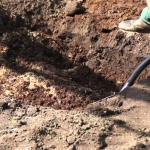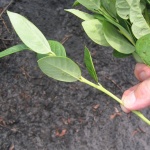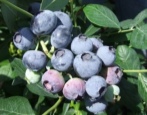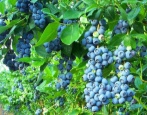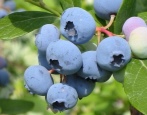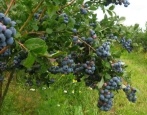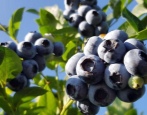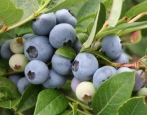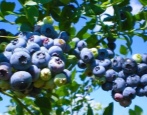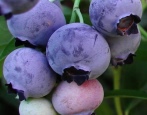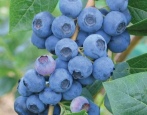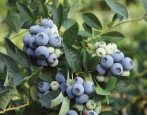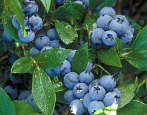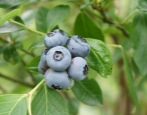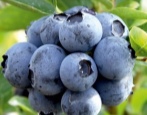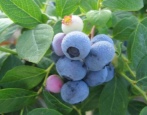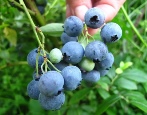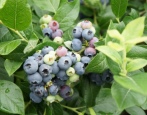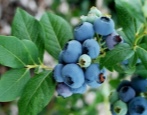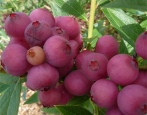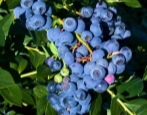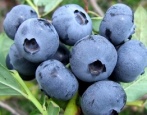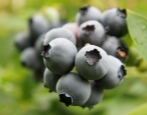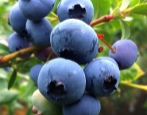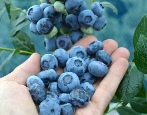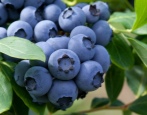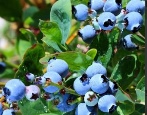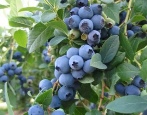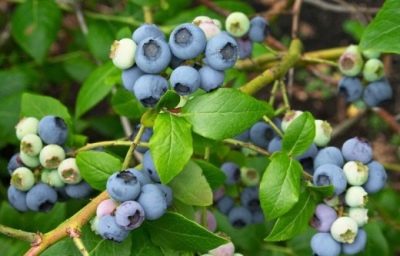
- Ripening terms: mid-early
- Growth type: medium-sized
- Bush height, m: 1,6-1,8
- Taste: good, sweet and sour
- Yield: high
- Average yield: 4-7 kg per bush
- Fruit size: medium
- Fruit color: light blue
- Description of the bush: upright
- Transportability: good
Erliblu blueberry is an early culture, it is famous not only for the excellent taste properties of the fruits, but also for the high level of their usefulness for humans. The composition of the nutrients contained in its pulp is truly unique. And its unpretentiousness when growing makes this process quite affordable even for novice gardeners.
Breeding history
Earliblue is an early type of berry bred in one of the regions of North America in 1952. It was entered in the State Register in 2005. However, today it is not listed there. But this does not prevent him from successfully growing up in many regions of Russia and Belarus.
Description of the variety
A culture with a fibrous root system, no suction roots. For this reason, it develops in symbiosis with heather fungi, which require an acidic environment for proper development. The roots are placed superficially, without going into the soil deeper than 40 cm. The bushes do not tolerate moisture stagnation well, but do not tolerate drought.
The stems of relatively tall, upright bushes (1.8-1.6 m) have reddish-brown tints. Shoot formation is inactive, so the crop does not need frequent pruning.
Leaves are rounded, smooth, greenish, shiny, arranged oppositely on the branches.
The flowers are light pinkish, star-shaped, outwardly inconspicuous.
The pluses of culture include:
early ripening of berries;
excellent level of frost resistance;
high degree of resistance to powdery mildew infection;
excellent taste properties of fruits;
unpretentiousness of culture;
versatility in use;
relatively good transportability;
no need for frequent pruning.
Minuses:
the fruits of the second and subsequent harvests are smaller in size than the fruits of the first harvest;
after 4-5 years of fruit bearing, seasons with low yields sometimes come;
poor development during dry seasons;
intolerance to stagnant water.
Fruit characteristics
Berries of medium size (up to 15 mm in diameter), weighing about 2 g, spherical configuration, light blue color, even, slightly flattened, grouped in dense and multi-fruited clusters, do not crumble for a long time after ripening. The shelf life of the berries is about 17 days. The fruits are not recommended for long-term storage.
The pulp is greenish with a modest pinkish tinge, of excellent quality.
The fruits of the culture are known for their unique qualities, the main ones of which are:
the protective effect of berries on the effects of radioactive radiation;
strengthening the blood vessels of the body;
normalization of cardiac function, bowel and pancreatic activity;
anti-aging effect on nerve cells;
berries have an antiscorbutic and anti-inflammatory effect, strengthen vision;
are an excellent cardiotonic and antihypertensive agent.
The fruits are recommended for use by workers in hazardous industries, since they effectively contribute to the elimination of heavy compounds from the body. Their high content of antioxidants, which neutralize free radicals, limits the occurrence of cancerous abnormalities. Infusions from the leaves of the culture are useful for the digestive system and for colds.
Taste qualities
The fruit tastes sweet and sour, slightly tart, with an exquisite wine and berry aroma.
Ripening and fruiting
The culture is medium early, ripens in the first decade of July. Sometimes fruiting is irregular, especially in five-year-old bushes, as well as in case of errors in feeding. Basically, fruiting is annual.
Yield
The average yield is 4-7 kg per bush.
Self-fertility and the need for pollinators
The culture requires cross-pollination. The flowering dates of the varieties selected for pollination should coincide with the beginning of July, which is guaranteed to ensure early ripening of the berries and their excellent quality.
Growing and care
The bushes are planted in pre-prepared planting recesses 50 cm wide and deep, with a distance between them not less than 1.5 m. The recesses should be filled with a substrate with the required acidity.
Bushes need feeding, systematic irrigation, pest control and infrequent pruning.
The level of crop yield largely depends on the quality of irrigation. It does not tolerate stagnation of moisture in the area of \ u200b \ u200bthe roots, but it also does not tolerate dry periods. For this reason, adherence to the irrigation schedule must be rigorous.
Seasoned gardeners are advised to water the bushes twice a week. In this case, irrigation is carried out both in the morning and in the evening. The volumes of liquid are determined by the condition of the soil and the amount of rain. On average, about 10 liters of water should go for each bush at a time.
During dry or hot periods, plants should be sprayed to prevent overheating in the sun.
Fertilizing crops are also carried out in accordance with a specific schedule:
mineral fertilizers are applied in the spring;
nitrogenous agents are added in June, July and August;
phosphorous compounds are introduced at the height of summer and at the beginning of autumn.
Culture does not accept organic matter.
Significant signs that blueberry bushes need soil acidification are yellowing and dry leaves. The goals are achieved by using specialized means, as well as by adding sulfur, ammonia, citric acid to the soil (up to 25 g per 5 liters of water).
Bushes do not need to be pruned annually. To preserve their health, they carry out sanitization starting from the 3rd year of growth. For this purpose, dried and diseased bushes are eliminated.

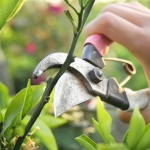
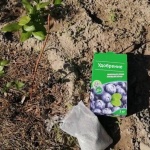
Disease and pest resistance
The culture is not very susceptible to diseases, but the selection of weak seedlings and poor-quality soil may well stimulate the occurrence of various diseases. Erliblu bushes are immune to powdery mildew infection, but are susceptible to gray rot - a fungal pathology that affects the upper part of them and causes berries to rot.Errors in agricultural care can also manifest itself in the appearance of other diseases - brown rot, anthracnose and others. Among such diseases there can be pathologies of both fungal and viral nature.
Pests that cause significant harm to the culture are birds, as an effective protection against which special nets are used.
Of the harmful insects, aphids are the most dangerous enemy. Feeding on the juices of young bushes, it causes irreparable damage to plants, contributing to the appearance of mold. White butterflies also bring harm to the bushes.
For the implementation of professional measures, typical special preparations are used, with which the bushes are treated with the beginning of spring.
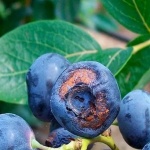
Winter hardiness and the need for shelter
The culture is highly resistant to frost (withstands up to -30 degrees Celsius), is able to recover soon after freezing. Traditionally, it does not require additional shelters for the winter, with the exception of regions where very low temperatures persist for a long time. In these cases, bark, spruce branches or pieces of non-woven fiber are used to organize shelters.

Location and soil requirements
The culture prefers lighted, warm areas. You should not plant bushes in shaded areas, as this will negatively affect the process of setting flower buds and the quality of ripening fruits. The lack of sunlight and the presence of high humidity will stimulate the occurrence of fungal pathologies. The culture grows and bears fruit productively on light sandy, acidic (3.5-4.5 pH) and well-drained soils.
